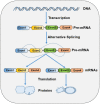Emerging Roles of SRSF3 as a Therapeutic Target for Cancer
- PMID: 33072610
- PMCID: PMC7544984
- DOI: 10.3389/fonc.2020.577636
Emerging Roles of SRSF3 as a Therapeutic Target for Cancer
Abstract
Ser/Arg-rich (SR) proteins are RNA-binding proteins known as constitutive and alternative splicing (AS) regulators that regulate multiple aspects of the gene expression program. Ser/Arg-rich splicing factor 3 (SRSF3) is the smallest member of the SR protein family, and its level is controlled by multiple factors and involves complex mechanisms in eukaryote cells, whereas the aberrant expression of SRSF3 is associated with many human diseases, including cancer. Here, we review state-of-the-art research on SRSF3 in terms of its function, expression, and misregulation in human cancers. We emphasize the negative consequences of the overexpression of the SRSF3 oncogene in cancers, the pathways underlying SRSF3-mediated transformation, and implications of potential anticancer drugs by downregulation of SRSF3 expression for cancer therapy. Cumulative research on SRSF3 provides critical insight into its essential part in maintaining cellular processes, offering potential new targets for anti-cancer therapy.
Keywords: RNA splicing; SRSF3; alternative splicing; cancer; oncogene.
Copyright © 2020 Zhou, Gong, Lin, Wang, Li, Wang, Ding and Li.
Figures






Similar articles
-
SRSF3: Newly discovered functions and roles in human health and diseases.Eur J Cell Biol. 2020 Aug;99(6):151099. doi: 10.1016/j.ejcb.2020.151099. Epub 2020 Jul 2. Eur J Cell Biol. 2020. PMID: 32800280 Review.
-
Oxidative stress-inducible truncated serine/arginine-rich splicing factor 3 regulates interleukin-8 production in human colon cancer cells.Am J Physiol Cell Physiol. 2014 Feb 1;306(3):C250-62. doi: 10.1152/ajpcell.00091.2013. Epub 2013 Nov 27. Am J Physiol Cell Physiol. 2014. PMID: 24284797
-
Identification of SRSF3 target mRNAs using inducible TRIBE.Biochem Biophys Res Commun. 2021 Nov 12;578:21-27. doi: 10.1016/j.bbrc.2021.09.019. Epub 2021 Sep 10. Biochem Biophys Res Commun. 2021. PMID: 34534741
-
Aberrant expression and regulatory network of splicing factor-SRSF3 in tumors.J Cancer. 2020 Mar 15;11(12):3502-3511. doi: 10.7150/jca.42645. eCollection 2020. J Cancer. 2020. PMID: 32284746 Free PMC article. Review.
-
MicroRNA-1908-5p contributes to the oncogenic function of the splicing factor SRSF3.Oncotarget. 2017 Jan 31;8(5):8342-8355. doi: 10.18632/oncotarget.14184. Oncotarget. 2017. PMID: 28039456 Free PMC article.
Cited by
-
Alternative Splicing Events and Their Clinical Significance in Colorectal Cancer: Targeted Therapeutic Opportunities.Cancers (Basel). 2023 Aug 7;15(15):3999. doi: 10.3390/cancers15153999. Cancers (Basel). 2023. PMID: 37568815 Free PMC article. Review.
-
SRSF3 Knockdown Inhibits Lipopolysaccharide-Induced Inflammatory Response in Macrophages.Curr Issues Mol Biol. 2024 Jun 20;46(6):6237-6247. doi: 10.3390/cimb46060372. Curr Issues Mol Biol. 2024. PMID: 38921043 Free PMC article.
-
Anti-proliferative effect and underlying mechanism of ethoxy-substituted phylloquinone (vitamin K1 derivative) from Spinacia oleracea leaf and enhancement of its extractability using radiation technology.3 Biotech. 2022 Oct;12(10):265. doi: 10.1007/s13205-022-03264-6. Epub 2022 Sep 8. 3 Biotech. 2022. PMID: 36091087 Free PMC article.
-
Circular RNA hsa_circ_0050386 suppresses non-small cell lung cancer progression via regulating the SRSF3/FN1 axis.J Transl Med. 2024 Jan 12;22(1):47. doi: 10.1186/s12967-023-04812-1. J Transl Med. 2024. PMID: 38216996 Free PMC article.
-
Analysis of RBP expression and binding sites identifies PTBP1 as a regulator of CD19 expression in B-ALL.Oncoimmunology. 2023 Mar 1;12(1):2184143. doi: 10.1080/2162402X.2023.2184143. eCollection 2023. Oncoimmunology. 2023. PMID: 36875548 Free PMC article.
References
Publication types
LinkOut - more resources
Full Text Sources
Research Materials
Miscellaneous

